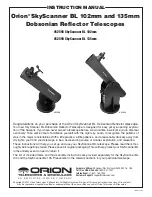
ENGLISH
I
10
Focal length of Telescope (mm)
Magnification
=
_____________________________
Focal length of Eyepiece (mm)
Let’s say, for example, you are using the 25mm eyepiece To determine the magnification you simply divide the focal
length of your telescope (for example, the NexStar 102SLT MAK has a focal length of 1325mm) by the focal length of the
eyepiece, 25mm Dividing 1325 by 25 yields a magnification of 53 power
Although the power is variable, each instrument under average skies has a limit to the highest useful magnification
The general rule is that 60 power can be used for every inch of aperture For example, the NexStar 102SLT MAK in
diameter Multiplying 4 by 60 gives a maximum useful magnification of 240 power Although this is the maximum useful
magnification, most observing is done in the range of 20 to 35 power for every inch of aperture which is 80 to 140 times
for the NexStar 102SLT MAK
CALCULATING
MAGNIFICATION
You can change the power of your telescope just by changing the eyepiece (ocular) To determine the magnification of
your telescope, simply divide the focal length of the telescope by the focal length of the eyepiece used In equation format,
the formula looks like this:
DETERMINING FIELD OF VIEW
Determining the field of view is important if you want to get an idea of the angular size of the object you are observing To
calculate the actual field of view, divide the apparent field of the eyepiece (supplied by the eyepiece manufacturer) by the
magnification In equation format, the formula looks like this:
Apparent Field of of Eyepiece
True Angular Field
=
________________________________
Magnification
As you can see, before determining the field of view, you must calculate the magnification Using the example in the
previous section, we can determine the field of view using the same 25mm eyepiece The 25mm eyepiece has an apparent
field of view of 50° Divide the 50° by the magnification, which is 53 power This yields an actual field of view of 94°
To convert degrees to feet at 1,000 yards, which is more useful for terrestrial observing, simply multiply by 52 5 Continuing
with our example, multiply the angular field 94° by 52 5 This produces a linear field width of 49 feet at a distance of one
thousand yards
GENERAL OBSERVING HINTS
When working with any optical instrument, there are a few things to remember to ensure you get the best possible image:
• Never look through window glass Glass found in household windows is optically imperfect, and as a result, may vary in
thickness from one part of a window to the next This inconsistency can and will affect the ability to focus your telescope In
most cases you will not be able to achieve a truly sharp image, while in some cases you may actually see a double image
• Never look across or over objects that are producing heat waves This includes asphalt parking lots on hot summer days
or building rooftops
• Hazy skies, fog, and mist can also make it difficult to focus when viewing terrestrially The amount of detail seen under these
conditions is greatly reduced
• If you wear corrective lenses (specifically glasses), you may want to remove them when observing with an eyepiece
attached to the telescope When using a camera, however, you should always wear corrective lenses to ensure the
sharpest possible focus If you have astigmatism, corrective lenses must be worn at all times
Содержание NexStar 102SLT 23090
Страница 1: ...INSTRUCTION MANUAL MAKSUTOV CASSEGRAIN 23090 ...
Страница 19: ...MODE D EMPLOI MAKSUTOV CASSEGRAIN 23090 ...
Страница 37: ...BEDIENUNGSANLEITUNG MAKSUTOV CASSEGRAIN 23090 ...
Страница 55: ...MANUAL DE INSTRUCCIONES MAKSUTOV CASSEGRAIN 23090 ...
Страница 73: ...MANUALE DI ISTRUZIONI MAKSUTOV CASSEGRAIN 23090 ...








































